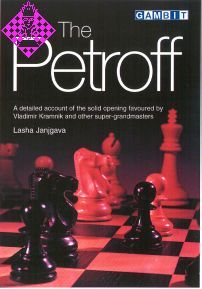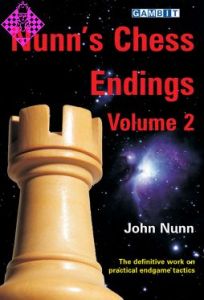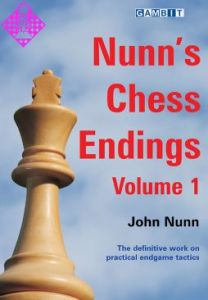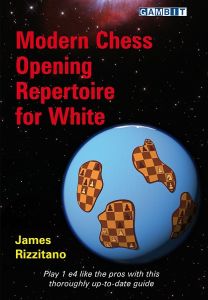Article Number
LOJANTP
Author
The Petroff
240 pages, paperback, Gambit, 1. edition 2001
Discontinued
The Petroff has for a long time been regarded as a very solid defence. Black avoids the perils of the Scotch, the Italian Game and above all the dreaded Ruy Lopez, and instead opts to neutralize White's initiative with active piece-play. In the Petroff, it is quite common for Black to launch an early counterattack, often gambling a pawn to do so.
For many years, the Petroff enjoyed a steady following, with Karpov, Ivanchuk, Timman, Anand, and in particular Yusupov among its supporters at top level. Since 1998, however, the Petroff's popularity has soared, following its adoption by Vladimir Kramnik, who has played it regularly and considerably reinforced its theoretical standing.
In this book, Janjgava gives a complete and detailed picture of the Petroff, taking recent developments fully into account. Readers will be fully equipped to take on either side of the Petroff with confidence in their own games.
For many years, the Petroff enjoyed a steady following, with Karpov, Ivanchuk, Timman, Anand, and in particular Yusupov among its supporters at top level. Since 1998, however, the Petroff's popularity has soared, following its adoption by Vladimir Kramnik, who has played it regularly and considerably reinforced its theoretical standing.
In this book, Janjgava gives a complete and detailed picture of the Petroff, taking recent developments fully into account. Readers will be fully equipped to take on either side of the Petroff with confidence in their own games.
The Petroff has for a long time been regarded as a very solid defence. Black avoids the perils of the Scotch, the Italian Game and above all the dreaded Ruy Lopez, and instead opts to neutralize White's initiative with active piece-play. In the Petroff, it is quite common for Black to launch an early counterattack, often gambling a pawn to do so.
For many years, the Petroff enjoyed a steady following, with Karpov, Ivanchuk, Timman, Anand, and in particular Yusupov among its supporters at top level. Since 1998, however, the Petroff's popularity has soared, following its adoption by Vladimir Kramnik, who has played it regularly and considerably reinforced its theoretical standing.
In this book, Janjgava gives a complete and detailed picture of the Petroff, taking recent developments fully into account. Readers will be fully equipped to take on either side of the Petroff with confidence in their own games.
For many years, the Petroff enjoyed a steady following, with Karpov, Ivanchuk, Timman, Anand, and in particular Yusupov among its supporters at top level. Since 1998, however, the Petroff's popularity has soared, following its adoption by Vladimir Kramnik, who has played it regularly and considerably reinforced its theoretical standing.
In this book, Janjgava gives a complete and detailed picture of the Petroff, taking recent developments fully into account. Readers will be fully equipped to take on either side of the Petroff with confidence in their own games.
| EAN | 9781901983463 |
|---|---|
| Weight | 310 g |
| Manufacturer | Gambit |
| Width | 14.5 cm |
| Height | 21 cm |
| Medium | Book |
| Year of Publication | 2001 |
| Author | Lasha Janjgava |
| Language | English |
| Edition | 1 |
| ISBN-10 | 1901983463 |
| ISBN-13 | 9781901983463 |
| Pages | 240 |
| Binding | paperback |
| Diagrams | 200 |
| Name | Gambit Publications Ltd. |
|---|---|
| Adresse | 27 Queens Pine, Bracknell Berkshire RG12 OTL Großbritannien |
| Internet | www.gambitbooks.com |
| info@gambitbooks.com |
Verantwortlicher Importeuer:
| Name | Schachversand Niggemann |
|---|---|
| Adresse | Schadowstraße 5 48163 Münster Deutschland |
| info@schachversand.de | |
| Internet | www.schachversand.de |
004 Symbols
005 Introduction
006 -01 Unusual Third Moves for White
017 -02 3d4 without 3...Sxe4
032 -03 3d4 Sxe4: Sidelines for White and Black
047 -04 3d4 Sxe4 4Ld3 d5 5Sxe5 Sd7
080 -05 3d4 Sxe4 4Ld3 d5 5Sxe5 Ld6
107 -06 Sxe5: Sidelines
119 -07 3Sxe5 d6 4Sf3 Sxe4: Sidelines
142 -08 4Sf3 Sxe4 5d4 d5 6Ld3 Sc6
155 -09 4Sf3 Sxe4 5d4 d5 6Ld3 Ld6
188 -10 4Sf3 Sxe4 5d4 d5 6Ld3 Le7
222 -11 The Main Line: 70-0 Sc6 8c4 Sb4
238 Index of Variations
005 Introduction
006 -01 Unusual Third Moves for White
017 -02 3d4 without 3...Sxe4
032 -03 3d4 Sxe4: Sidelines for White and Black
047 -04 3d4 Sxe4 4Ld3 d5 5Sxe5 Sd7
080 -05 3d4 Sxe4 4Ld3 d5 5Sxe5 Ld6
107 -06 Sxe5: Sidelines
119 -07 3Sxe5 d6 4Sf3 Sxe4: Sidelines
142 -08 4Sf3 Sxe4 5d4 d5 6Ld3 Sc6
155 -09 4Sf3 Sxe4 5d4 d5 6Ld3 Ld6
188 -10 4Sf3 Sxe4 5d4 d5 6Ld3 Le7
222 -11 The Main Line: 70-0 Sc6 8c4 Sb4
238 Index of Variations
Wenn man bedenkt, dass z. B. das bekannte Jussupow - Werk (von einem etwas aktuelleren Anhang abgesehen) etwa Mitte der 90er-Jahre endet, ist man für alles Neue über Russisch aus kompetenter Quelle dankbar, denn diese Eröffnung entwickelt sich so schnell, dass praktisch nach jedem großen Turnier irgend etwas neu geschrieben werden könnte (und ein Ende des Booms ist noch keineswegs abzusehen). GM Janjgava präsentiert nun in der Tat einen ziemlich aktuellen Stand der Theorie mit Partien noch aus 2000 (aus 2001 ist allerdings, so weit ich gesehen habe, noch nichts dabei). Die alten Meister sind dabei aber nicht völlig ad acta gelegt worden; in Varianten, wo es weniger Neues gibt, findet man auch noch Partien von Marshall oder sogar Morphy. Wenn man vollständig sein will, führt dies natürlich andererseits oft dazu, dass die Menge an Varianten einen gewaltigen Umfang erreicht (zumal es im Russisch viele konkrete taktische Abspiele gibt und die Hauptsysteme oft schon bis weit über den 20. Zug hinaus analysiert sind). In der Tat dominieren die Varianten, textliche Erläuterungen sind durchaus auch vorhanden, in der Regel erreichen sie aber nur zu Beginn einer Variante oder in kritischen Stellungen einen größeren Umfang. Mir selbst erscheint dies ausreichend, es ist aber sicher kein Einführungsbuch für Amateure, sondern etwas für echte Turnierspieler, die möglichst schon Russisch - Vorkenntnisse mitbringen sollten, oder zumindest Zeit, Interesse und Spielstärke, um sich in Feinheiten einzuarbeiten.
Etwas eigene Nacharbeit kann auch bei einem zweifellos qualifizierten Werk ohnehin nichts schaden. Zum einen hat sich natürlich schon längst wieder hie und da Neues getan; auch sind mir z. B. diverse Nicht - Übereinstimmungen mit dem Informator - Material aufgefallen (Partien, die nicht im Buch sind, oder verschiedene Beurteilungen derselben Stellung bzw. Variante, wo man sich selbst klar werden muss). Nicht finden konnte ich etwa im Hauptsystem 6. Le7 7. 0-0 Sc6 8. c4 Sb4 9. Le2 0-0 10. Sc3 (S. 228) die Variante 10. -b6, die immerhin in hochkarätigen Partien wie Kasparow-Anand oder Kasparow-Kramnik angewandt wurde. Auch hätte m. E. im selben System zur Variante 8. Te1 Lg4 9. c4 Sf6 10. cxd5 (S. 208) ein Hinweis auf 10. -Lxf3 11. Dxf3 Dxd5 gehört - die daraus entstehende Stellung wird zwar ausführlich behandelt, aber an anderer Stelle mit einer m. E. weit weniger wahrscheinlichen Zugfolge. Wen die rasante Entwicklung dieser Eröffnung, ihre Variantenfülle und die Computeranalysierbarkeit vieler kritischer Stellungen nicht abschreckt (ich selbst frage mich in der Tat, ob man Russisch speziell auf höherer Ebene noch spielen kann, wenn man kein Vollprofi ist), für den wird dies sicher ein „Pflichtbuch" sein. Gerd Treppner, Rochade Europa, 10/2001
Etwas eigene Nacharbeit kann auch bei einem zweifellos qualifizierten Werk ohnehin nichts schaden. Zum einen hat sich natürlich schon längst wieder hie und da Neues getan; auch sind mir z. B. diverse Nicht - Übereinstimmungen mit dem Informator - Material aufgefallen (Partien, die nicht im Buch sind, oder verschiedene Beurteilungen derselben Stellung bzw. Variante, wo man sich selbst klar werden muss). Nicht finden konnte ich etwa im Hauptsystem 6. Le7 7. 0-0 Sc6 8. c4 Sb4 9. Le2 0-0 10. Sc3 (S. 228) die Variante 10. -b6, die immerhin in hochkarätigen Partien wie Kasparow-Anand oder Kasparow-Kramnik angewandt wurde. Auch hätte m. E. im selben System zur Variante 8. Te1 Lg4 9. c4 Sf6 10. cxd5 (S. 208) ein Hinweis auf 10. -Lxf3 11. Dxf3 Dxd5 gehört - die daraus entstehende Stellung wird zwar ausführlich behandelt, aber an anderer Stelle mit einer m. E. weit weniger wahrscheinlichen Zugfolge. Wen die rasante Entwicklung dieser Eröffnung, ihre Variantenfülle und die Computeranalysierbarkeit vieler kritischer Stellungen nicht abschreckt (ich selbst frage mich in der Tat, ob man Russisch speziell auf höherer Ebene noch spielen kann, wenn man kein Vollprofi ist), für den wird dies sicher ein „Pflichtbuch" sein. Gerd Treppner, Rochade Europa, 10/2001
More from Gambit
-
 Schach für Kinder€17.95
Schach für Kinder€17.95 -
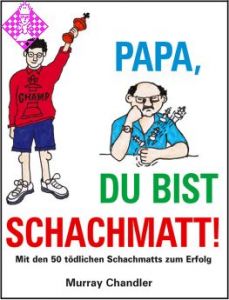 Papa, Du bist Schachmatt!€16.50
Papa, Du bist Schachmatt!€16.50 - More from Gambit

